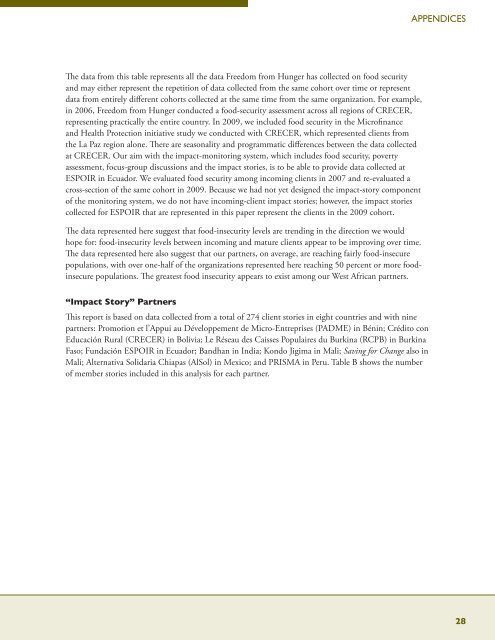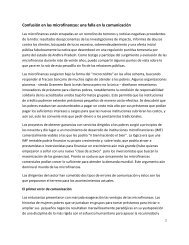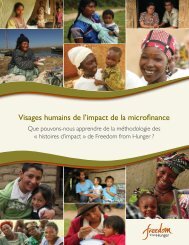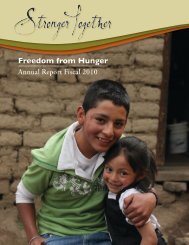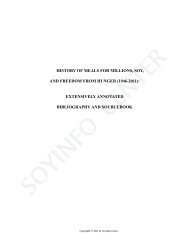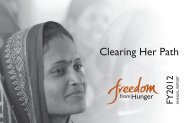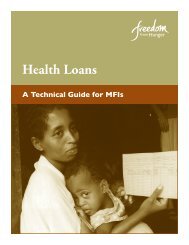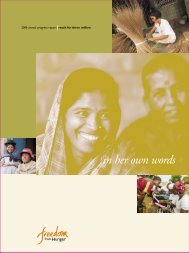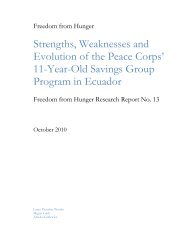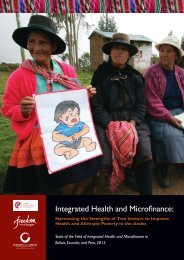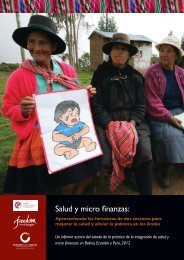English - Freedom from Hunger
English - Freedom from Hunger
English - Freedom from Hunger
Create successful ePaper yourself
Turn your PDF publications into a flip-book with our unique Google optimized e-Paper software.
The data <strong>from</strong> this table represents all the data <strong>Freedom</strong> <strong>from</strong> <strong>Hunger</strong> has collected on food security<br />
and may either represent the repetition of data collected <strong>from</strong> the same cohort over time or represent<br />
data <strong>from</strong> entirely different cohorts collected at the same time <strong>from</strong> the same organization. For example,<br />
in 2006, <strong>Freedom</strong> <strong>from</strong> <strong>Hunger</strong> conducted a food-security assessment across all regions of CRECER,<br />
representing practically the entire country. In 2009, we included food security in the Microfinance<br />
and Health Protection initiative study we conducted with CRECER, which represented clients <strong>from</strong><br />
the La Paz region alone. There are seasonality and programmatic differences between the data collected<br />
at CRECER. Our aim with the impact-monitoring system, which includes food security, poverty<br />
assessment, focus-group discussions and the impact stories, is to be able to provide data collected at<br />
ESPOIR in Ecuador. We evaluated food security among incoming clients in 2007 and re-evaluated a<br />
cross-section of the same cohort in 2009. Because we had not yet designed the impact-story component<br />
of the monitoring system, we do not have incoming-client impact stories; however, the impact stories<br />
collected for ESPOIR that are represented in this paper represent the clients in the 2009 cohort.<br />
The data represented here suggest that food-insecurity levels are trending in the direction we would<br />
hope for: food-insecurity levels between incoming and mature clients appear to be improving over time.<br />
The data represented here also suggest that our partners, on average, are reaching fairly food-insecure<br />
populations, with over one-half of the organizations represented here reaching 50 percent or more foodinsecure<br />
populations. The greatest food insecurity appears to exist among our West African partners.<br />
“Impact Story” Partners<br />
This report is based on data collected <strong>from</strong> a total of 274 client stories in eight countries and with nine<br />
partners: Promotion et l’Appui au Développement de Micro-Entreprises (PADME) in Bénin; Crédito con<br />
Educación Rural (CRECER) in Bolivia; Le Réseau des Caisses Populaires du Burkina (RCPB) in Burkina<br />
Faso; Fundación ESPOIR in Ecuador; Bandhan in India; Kondo Jigima in Mali; Saving for Change also in<br />
Mali; Alternativa Solidaria Chiapas (AlSol) in Mexico; and PRISMA in Peru. Table B shows the number<br />
of member stories included in this analysis for each partner.<br />
aPPendICes<br />
28


